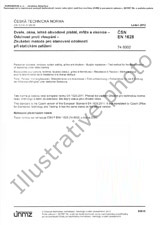We need your consent to use the individual data so that you can see information about your interests, among other things. Click "OK" to give your consent.
ČSN EN ISO 17511-ed.2 (857020)
In vitro diagnostic medical devices - Requirements for establishing metrological traceability of values assigned to calibrators, trueness control materials and human samples
Translate name
STANDARD published on 1.12.2021
The information about the standard:
Designation standards: ČSN EN ISO 17511-ed.2
Classification mark: 857020
Catalog number: 513191
Publication date standards: 1.12.2021
SKU: NS-1043013
The number of pages: 72
Approximate weight : 216 g (0.48 lbs)
Country: Czech technical standard
Category: Technical standards ČSN
The category - similar standards:
Annotation of standard text ČSN EN ISO 17511-ed.2 (857020):
This document specifies technical requirements and documentation necessary to establish metrological traceability of values assigned to calibrators, trueness control materials and human samples for quantities measured by IVD MDs. The human samples are those intended to be measured, as specified for each IVD MD. Metrological traceability of values for quantities in human samples extends to the highest available reference system component, ideally to RMPs and certified reference materials (CRMs).
All parties having a role in any of the steps described in a calibration hierarchy for an IVD MD are subject to the requirements described. These parties include but are not limited to manufacturers (of IVD MDs), RMP developers (see ISO 15193), RM producers (see ISO 15194), and reference/calibration laboratories (see ISO 15195) supporting calibration hierarchies for IVD MDs.
NOTE 1 - Producers of RMs intended for use in standardization or calibration of IVD MDs include commercial and non-commercial organizations producing RMs for use by many end-users of IVD MDs and/or calibration laboratories, or for use by a single end-user medical laboratory, as in the case of a measurement standard (calibrator) intended to be used exclusively for calibration of a laboratory-developed MP.
This document is applicable to:
- a) all IVD MDs that provide measurement results in the form of numeric values, i.e. rational (ratio) and/or differential (interval) scales, and counting scales.
- b) IVD MDs where the measurement result is reported as a qualitative value established with a ratio of two measurements (i.e. the signal from a specimen being tested and the signal from a RM with a specified concentration or activity at the cut-off), or a counting scale, with corresponding decision threshold(s). This also includes IVD MDs where results are categorized among ordinal categories based on pre-established quantitative intervals for a quantity.
- c) RMs intended for use as trueness control materials for verification or assessment of calibration of IVD MDs, i.e. some commutable CRMs and some external quality assessment (EQA) materials (if so indicated in the RM´s intended use statement).
- d) IVD MD-specific calibrators and trueness control materials with assigned values, intended to be used together with a specified IVD MD.
- e) IVD MDs as described in a) and b), where no end-user performed calibration is required (i.e. when the manufacturer performs a factory calibration of the IVD MD).
This document is not applicable to:
- a) calibrators and trueness control materials for IVD MDs which, due to their formulation, are known to have zero amount of measurand;
- b) control materials that are used only for internal quality control purposes in medical laboratories to assess the imprecision of an IVD MD, either its repeatability or reproducibility, and/or for assessing changes in IVD MD results compared to a previously established calibration condition;
- c) control materials that are used only for internal quality control purposes in medical laboratories and which are supplied with intervals of suggested acceptable values that are not metrologically traceable to higher order reference system components;
- d) properties reported as nominal scales and ordinal scales, where no magnitude is involved.
NOTE 2 - Nominal scales are typically used to report e.g. identity of blood cell types, microorganism types, identity of nucleic acid sequences, identity of urine particles.
NOTE 3 - Ordinal scales are often applied to results differentiated into dichotomous groupings (e.g. ´sick´ vs. ´healthy´), and occasionally to results differentiated into non-dichotomous categories where the result categories are rank-ordered but the rank-ordered categories cannot be differentiated in terms of relative degree of difference, e.g. negative, +1, +2, +3 for grading of presence of haemoglobin in urine specimens by visual observation
Preview of the standard ČSN EN ISO 17511-ed.2 (857020)
We recommend:
Updating of laws
Do you want to be sure about the validity of used regulations?
We offer you a solution so that you could use valid and updated legislative regulations.
Would you like to get more information? Look at this page.




 Cookies
Cookies
